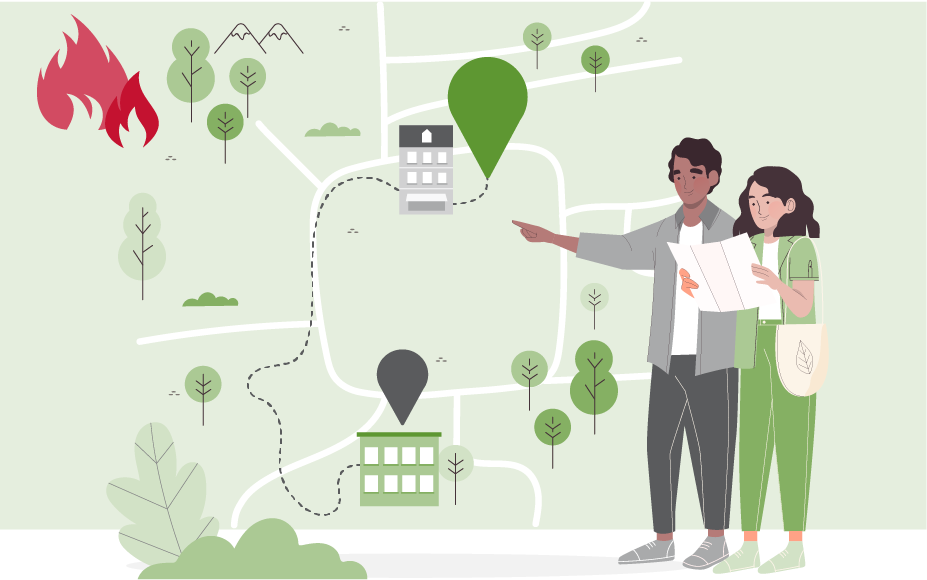Create A Plan for Wildfire Survival
The Best Way to Survive a Wildfire is to Have A Plan.
Knowing that a threat of wildfire is in your area lets you start planning your evacuation. Set up wildfire warnings and alerts so that you are first to know.
- Have several ways to receive alerts. Download the FEMA app and receive real-time alerts from the National Weather Service for up to five locations nationwide.
- Sign up for community alerts in your area and be aware of the Emergency Alert System (EAS) and Wireless Emergency Alert (WEA)- which requires no-sign up.
- Pay attention to air quality alerts.
- Get a communications device that will allow you to access AM/FM/NOAA Weather Radio when cell towers are not available. Make sure you have walkie talkies to communicate with your family members should cell service become unavailable.
Make your emergency plan now.
- Make sure everyone in your household knows and understands what to do if you need to quickly evacuate. Have several evacuation routes in case one of your routes is compromised. Determine a place for your family to meet should you not be together when evacuating.
- Keep all your safety equipment in your Go Bag and store them in an easily accessible area in your home so you can put them on quickly if you cannot evacuate safely, or are unsure if you can evacuate safely.
- If evacuation seems impossible, have a plan for that, such as an InGround Fire Safety Shelter.
Review Important Documents
- Make sure your insurance policies and personal documents, such as your ID, are up to date.
- Wills, deeds, titles and other essential should be easy to grab in a fire proof box, or stored in an off-site location, such as a Security Deposit box at the bank.
- Make copies and keep them in a secure password protected digital space.
Strengthen your Home
- Use fire-resistant materials to build, renovate or make repairs.
- Find an outdoor water source with a hose that can reach any area of your property.
- Create a fire-resistant zone that is free of leaves, debris or flammable materials for at least 30 feet from your home.
- Designate a room that can be closed off from outside air. Close all doors and windows. Set up a portable air cleaner to keep indoor pollution levels low when smoky conditions exist. Get a Fire Escape Mask for each member of your family, so they don't succumb to smoke inhalation.
- Install an InGround Fire Safety Shelter from Family Wildfire Survival Equipment.
Know your Evacuation Zone

- You may have to evacuate quickly due to a wildfire. Learn your evacuation routes, practice with household, pets, and identify where you will go.
- If you must evacuate to a public shelter, try to bring items that can help protect you and others in the shelter from COVID-19, such as hand sanitizer, cleaning materials, and two masks per person. Children under 2 years old and people who have trouble breathing should not wear masks. COVID-19
- Follow the instructions from local authorities. They will provide the latest recommendations based on the threat to your community and appropriate safety measures.
- Review the CDC’s guidelines for “Going to a Public Disaster Shelter During the COVID-19 Pandemic.” COVID-19
Gather Supplies
- Have enough supplies for your household, include medication, disinfectant supplies, masks, pet supplies in your go bag or car trunk.
- If you already have an N95 mask, use this to protect yourself from smoke inhalation. N95 masks also protect against the spread of COVID-19, however they should be reserved for healthcare workers. If are in a public cleaner air space or shelter, use a mask to help slow the spread of COVID-19. COVID-19
- Keep your cell phone charged when wildfires could be in your area. Purchase backup charging devices to power electronics, such as the Galadriel Emergency Solar Hand Crank Portable Radio.
Stay Safe During
- Evacuate immediately if authorities tell you to do so!
- If trapped, then call 911 and give your location, but be aware that emergency response could be delayed or impossible. Turn on lights to help rescuers find you. If you have an InGround Fire Safety Shelter, make sure all persons in you household are able to enter it immediately. Once in, shut of all three doors and wait for the fire to pass. Check the viewing portal and the temperature gauge to know when it is safe to exit.
- Pay attention to any health symptoms if you have asthma, COPD, heart disease, or are pregnant. If you are sick and need medical attention, contact your healthcare provider for further care instructions and shelter in place, if possible. If you are experiencing a medical emergency, call 9-1-1.
- Pay attention to emergency alerts and notifications for information and instructions.
- Use an N95 mask to protect yourself from smoke inhalation, or one of our SCBA tank with masks so you can breathe clean air.
- If you are not ordered to evacuate but smoky conditions exist, stay inside in a safe location or go to a community building where smoke levels are lower.
Returning Home After a Wildfire
- Do not return home until authorities say it is safe to do so.
- Avoid hot ash, charred trees, smoldering debris, and live embers. The ground may contain heat pockets that can burn you or spark another fire.
- Make sure you wear protective equipment that we provide, including our boots to make sure your feet are protected. Wear one of our fireman's hoods to protect your head, face and neck.
- When cleaning, wear protective clothing, including a long-sleeved shirt, long pants, work gloves, appropriate cloth face coverings or masks, and sturdy thick-soled shoes during clean-up efforts.
- Use appropriate masks or respirators.
- When cleaning up ash, use a respirator to limit your exposure and wet debris to minimize breathing dust particles
- People with asthma and/or other lung conditions should take precautions in areas with poor air quality, as it can worsen symptoms. Children should not help with clean-up efforts.
- Send text messages or use social media to reach out to family and friends. Phone systems are often busy following a disaster. Having a solar powered / hand crank powered communications device that will recharge your cell phones is essential.
- Document property damage with photographs. Conduct an inventory and contact your insurance company for assistance.
- Sourced from ready.gov/wildfires



